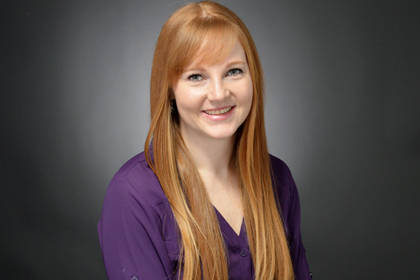In December 2018, Danielle Smith ’20 was two weeks into her six-week family medicine rotation and hadn’t yet selected a community health project topic. Then, a series of serendipitous events pointed her in the perfect direction, starting with a Family Medicine Ground Rounds presentation by W. Stephen Faraci, Ph.D., founder and chief scientific officer at CYTA Therapeutics, Inc. in Lowell, Mass., called “Medical Marijuana: Overview and Potential Use for Family Medicine Doctors.”

Danielle Smith, UVM Larner College of Medicine Class of 2022
The third-year Community Health Improvement Project requirement in the family medicine clerkship aims to train students to identify a health-related issue within the community in which they’re completing their rotation, determine public health costs associated with the issue, propose a way to address the issue, and report their results back to their preceptors.
In December 2018, Danielle Smith ’20 was two weeks into her six-week family medicine rotation and hadn’t yet selected a community health project topic. Then, a series of serendipitous events pointed her in the perfect direction, starting with a Family Medicine Ground Rounds presentation by W. Stephen Faraci, Ph.D., founder and chief scientific officer at CYTA Therapeutics, Inc. in Lowell, Mass., called “Medical Marijuana: Overview and Potential Use for Family Medicine Doctors.”
With her interest piqued, she made a mental note to do more research on the topic and returned to her rotation.
By the end of that week, Smith had witnessed about eight patients asking the providers she was shadowing about cannabis products – both CBD and THC – for use in treating their various ailments. Following the first few of these interactions, she asked Robert Luebbers, M.D., associate professor of family medicine and a provider she was shadowing, about his comfort level in providing recommendations to patients who ask about medical marijuana.
“I have patients ask me about medical marijuana and CBD all the time,” Luebbers said. “I just don’t know enough about it to feel really comfortable recommending it. It would be super helpful to have more information about potentially using medical cannabis as an alternative to less desirable medications for things like pain and insomnia.”
Luebbers’ answer was all Smith needed to confirm that her community health improvement project could focus on the comfort level or, rather, discomfort of local providers in addressing medical marijuana questions from patients.
Over the next few weeks, Smith interviewed both Ada Puches, the community outreach coordinator for Champlain Valley Dispensaries and Southern Vermont Wellness, and Paul Jerard, PA-C, the owner and operator of Vermont Cannabinoid Clinic. She also referenced peer-reviewed, evidence-based research papers to gather information about therapeutic effects of medical cannabis, pharmacology, drug interactions, contraindications, and more. Additionally, she surveyed the six providers at her clerkship location, UVM Medical Center Family Medicine in South Burlington, to assess their comfort level with recommending medical cannabis to patients for qualifying or indicated conditions.
With her research and interview notes in hand, Smith created an educational one-page, front-and-back handout she titled “A Provider’s Guide to Medical Cannabis: THC and CBD - Putting the Evidence to Work for Improved Patient Care.” The handout presents an overview of medical cannabis; clinical evidence about the health effects of medical cannabis from a report by the National Academies of Science, Engineering, and Medicine; a breakdown of the difference between THC and CBD; and dosing recommendations, routes of administration, contraindications, and adverse effects. The handout was then distributed to the six providers she had previously surveyed and they were asked to fill out a second survey – indicating their level of comfort in recommending medical cannabis after reading through the handout and having the ability to use it as a quick reference guide.
Preliminary results of Smith’s second survey indicated that the handout was effective in increasing provider confidence and the likelihood that they would recommend medical cannabis as a therapeutic intervention when evidentially indicated.
Smith realizes that her evaluation sample size was small and further research that measures the overall effectiveness of such interventions is needed, but hopes the handout and the idea behind it will catch on.
“The field of medical cannabis is a burgeoning field of research with new evidence published daily,” Smith says. “A future medical student could update the handout based on the most up-to-date information annually following publishing of new high quality evidence.”
View Smith's educational handout “A Provider’s Guide to Medical Cannabis: THC and CBD - Putting the Evidence to Work for Improved Patient Care" here.